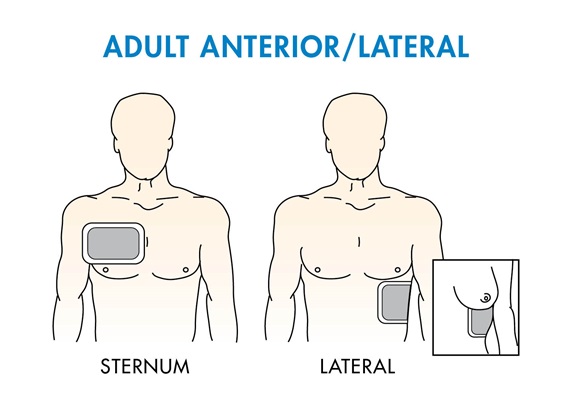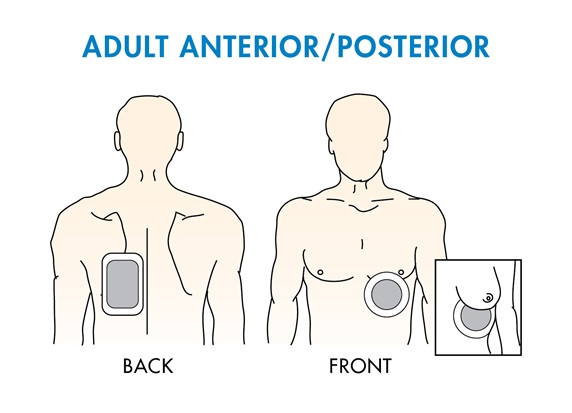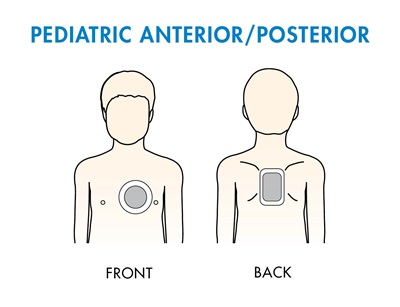Aed Pads Should Be Placed
Defibrillator Pad Placement
Optimizing Current Delivery
In sudden cardiac arrest (SCA), the heart stops beating in a productive manner and is unable to efficiently pump claret to the brain and other vital organs. Rescuers must shock the eye with enough current from an automatic external defibrillator (AED) or transmission defibrillator to interrupt the irregular activity and allow the center to resume a normal cardiac rhythm.
Electrodes, commonly referred to every bit pads, adhere to a victim'southward breast and connect to a defibrillator. The pad allows the AED to analyze a middle's rhythm, and if necessary, comport electric current to the centre.
Careful pad placement allows for the near direct and unobstructed path of transthoracic electric current (TTC). Improper pad placement and the presence of a variety of substances tin create resistance to electric current menses, also called transthoracic impedance (TTI). This guide explains pad placement and other important considerations to keep in listen when defibrillating adult and pediatric SCA victims.
Positioning Pads on Adults
Both adult and pediatric electrodes come up packaged with elementary graphics showing placement that will optimize the delivery of current. Electrode placement may vary by manufacturer, so be certain to review your electrode'southward instructions before you find yourself in a rescue state of affairs.
In general, nevertheless, the American Heart Clan (AHA) recommends two basic ways to position pads when treating adult victims: anterior-lateral and anterior-posterior.i When pads are placed anterior-laterally, or front-side, 1 electrode is placed on the victim's upper right trunk above the right nipple, just beneath the clavicle, and the other (lateral) pad should align with the bottom portion of the pectoral musculus on a male patient or under the breast on a female patient.
Alternatively, rescuers may cull to identify pads in an anterior-posterior position, or front end-back. Place the posterior pad to the left of the spine just below the scapula at the eye level. Place the front pad over the cardiac apex betwixt the midline of the chest and nipple on a male victim or under the chest on a female person. Both arrangements allow the AED to analyze the victim'due south heart and deliver a shock if necessary.


ZOLL® Electrodes
When using the ZOLL defibrillator, rescuers should attach pads to victims as indicated on the packaging of the ZOLL electrodes:
- Identify one electrode to the right of the patient'southward sternum (patient's right), only beneath the clavicle.
- Place the other electrode just below and to the left of the patient'due south left nipple, along the inductive-axillary line.
Positioning Pads on a Kid
Children suffering from sudden cardiac arrest are treated in the same fashion as adults, with one significant departure. Considering children require less energy during defibrillation, the current delivered must be attenuated, or reduced, through the use of specially designed pediatric pads. For this reason, the AHA recommends that whatsoever kid under 8 years of age should be defibrillated using pediatric pads.ii
It is likewise important that electrodes don't overlap or make contact during defibrillation. A child's smaller physical size can brand information technology a challenge to position both electrodes on the chest without any overlap. To ensure safe pediatric defibrillation, the best location for pads is the inductive-posterior (front end-dorsum) configuration. 1 electrode is placed on the front (anterior) chest wall and the other on the center of the child's dorsum (posterior)
The American Centre Association (AHA) states anterior-lateral placement or anterior-posterior placement may be reasonable to defibrillate pediatric victims,2 however ZOLL pediatric electrodes are designed to be used in anterior-posterior placement equally shown in the images below. Attach the back pad middle along the spine of the victim. Attach the front pad over the cardiac apex between the midline of the chest and nipple.

Pad size
In an emergency, EMS rescuers should always act as quickly as possible, using the electrodes provided with the defibrillator at hand. To ensure that your AED is properly outfitted with appropriately sized adult and pediatric electrodes, the American Heart Association offers some guidance:
- Larger electrodes have been shown to lower transthoracic impedance, then the AHA suggests using developed electrodes that are between 8–12 cm (3.14–four.72 inches) in bore.1
- To attain the all-time outcomes when defibrillating a child, pediatric electrodes should also be as big as possible, while still providing 3 cm (one.xviii inches) of space between the edges of the pads.
- When defibrillating infants and pocket-sized children under viii years of age or weighing less than 25 kg (55 lb), the AHA recommends using pediatric electrodes. 2
Elements of Successful Defibrillation
In addition to appropriate pad size and position, there are other factors EMS and hospital clinicians need to consider when preparing to defibrillate a victim.
Above all, it is important to make sure that the pads are completely adhered to the victim's pare. Air pockets or gaps between peel and the pads can lead to the possibility of arcing and burns. To avoid this, apply one edge of the pad deeply to the patient. Roll the pad smoothly from the applied edge to the other, existence careful non to trap any air pockets between the pad and the skin.
Items on a victim'southward body can interfere with the delivered current and some elements can even create impedance, or resistance, to electric current. To ensure the all-time possible outcome, pay shut attending to the following list and quickly prepare the victim prior to defibrillation:
Jewelry: Remove all of a victim's metal jewelry, including nipple piercings and necklaces, that may come in contact with electrodes.1
Chest hair: If the victim has excessive chest hair, speedily shave it with the razor provided with the AED earlier you apply pads to ensure proper adhesion. Those who are at risk for or who have already experienced SCA are encouraged to regularly remove chest hair.3
Breast tissue: Significant chest tissue can contribute to impedance. To accommodate for this, the AHA recommends placing the electrode beneath the tissue, using one hand to drag the breast tissue and the other to apply the pad.3
Moisture: Excessive moisture can interfere with adhesion and electricity conduction. Move the victim and the AED away from sources of water, remove whatever wet clothing, and dry the victim to the all-time of your ability earlier applying electrodes.
Acceptable pressure: Pad placement depends on adequate pressure. Studies have recommended that at least 80 Northward of force be practical when adhering pads to a victim, so information technology'due south best to press downward as firmly as possible to ensure proper application.4
These guidelines should assistance you lot respond in the event of an SCA. For further data, always refer to your AED manual or the American Heart Association website.
1Panchal AR, et al. Apportionment. 2020;142:sixteen:S366–S468.
twoTopjian AA, et al. Circulation. 2020;142:xvi:S469–523.
3Jacobs I, et al. Circulation. 2010;122:xvi:S325–S337.
4Sado DM, et al.J R Soc Med. 2005;98:i:3–6.
Additional Resource
What Is Avant-garde Life Support
What Is Basic Life Support
How to Maintain an AED
ZOLL Accessories
Right Pad Placement Thumbnail Row Title
Aed Pads Should Be Placed,
Source: https://www.zoll.com/resources/correct-pad-placement
Posted by: calderonmisiongs71.blogspot.com


0 Response to "Aed Pads Should Be Placed"
Post a Comment